
The Brooke Bond tea plantation at Kericho, Kenya 1963
In April 1963, having just recovered from a year of illness, and facing the responsibility of providing for a family that now included three young boys, Adrian Flowers was commissioned to travel to Africa and India, to photograph tea plantations for the Brooke Bond company. It was too good an opportunity to pass up; by this time Brooke Bond had overtaken Lyons to become the largest tea company in the world. With plantations in India, Ceylon and Africa, it employed over 50,000 people. In Britain, Brooke Bond tea and PG Tips were popular brands, with the company using traditional forms of marketing, such as collectors cards, and also maintaining a fleet of distinctive red delivery vans. In the 1950s, the company ran a campaign entitled “The Story of Tea”, with a series of full-page colour documentary-style ads in magazines, depicting smiling workers planting, harvesting and processing tea. The accompanying texts were of their time: “The forest has been beaten. The matted undergrowth and tangled vines are gone. The trees have been felled and uprooted. Shade trees have been planted. A new tea estate is born. . .”
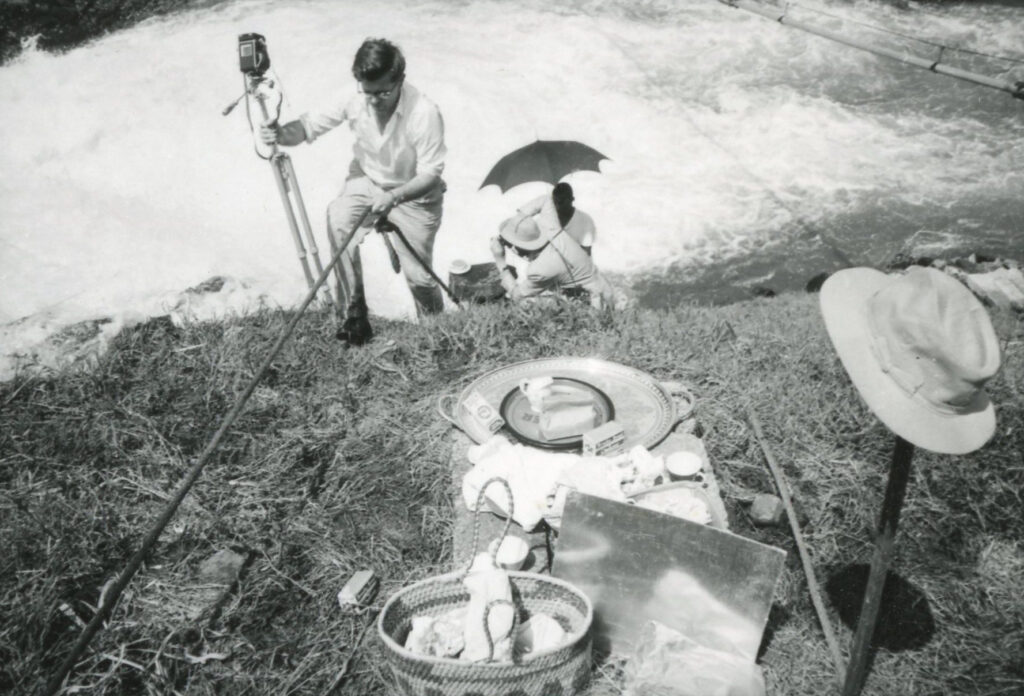
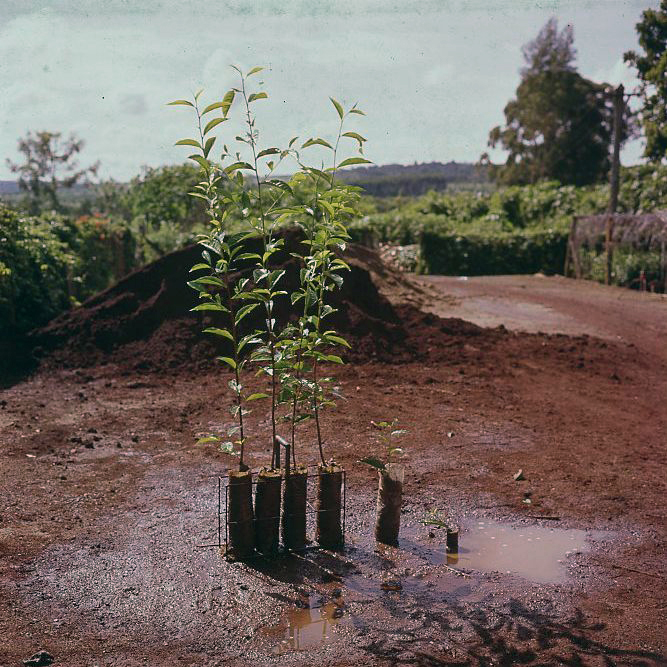
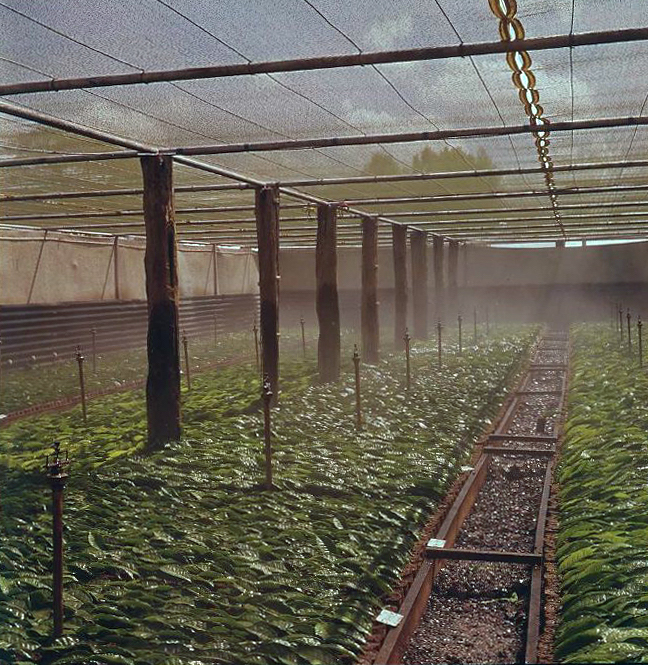
By 1963, the “Story of Tea” ads were looking old-fashioned and Bill Barter of the advertising firm Spotiswoode wanted to try something new; he contacted Adrian Flowers and asked him to tour the Brooke Bond plantations with his camera, taking photographs of both the growing and processing of tea, and also some marketing images. There was also a political edge to the commission: on June 1st of that year, Jomo Kenyatta was being sworn in as the new Prime Minister of Kenya, and six months later the country would declare independence from Britain. After reaping the benefits of eight decades of colonial rule, Brooke Bond would have been nervous about the future of their plantation at Kericho, which occupied prime farm land in the Rift Valley. Ostensibly, Flowers was asked to photograph the cultivation of tea for an updated Tea Story, but there may also have been a propaganda element to his tour, with Brooke Bond assembling evidence of good management, to help retain ownership of the plantation.
Going back half a century, in 1905, a massacre of Kipsigis warriors had paved the way at Kericho for a land grab by British interests. Anyone who resisted colonial rule was forcibly re-located. Initially the farms at Kericho were intended to cultivate flax, and the British East African Disabled Officers Cooperative (Beadoc) invested heavily in this project. However there was a collapse in the price of flax and Beadoc ran up substantial debts. At an auction in 1925, Brooke Bond and James Finlay bought the lands at Kericho, for £3 an acre. By 1963 the Brooke Bond plantation covered thirty thousand acres. Although the agreement whereby Kenya achieved independence called for the return of tribal lands, this was not done in the case of Kericho, and today the matter is still in dispute in Kenya’s law courts. Britain has declined to accept responsibility, stating as it is more than thirty years since independence, the case cannot be pursued.

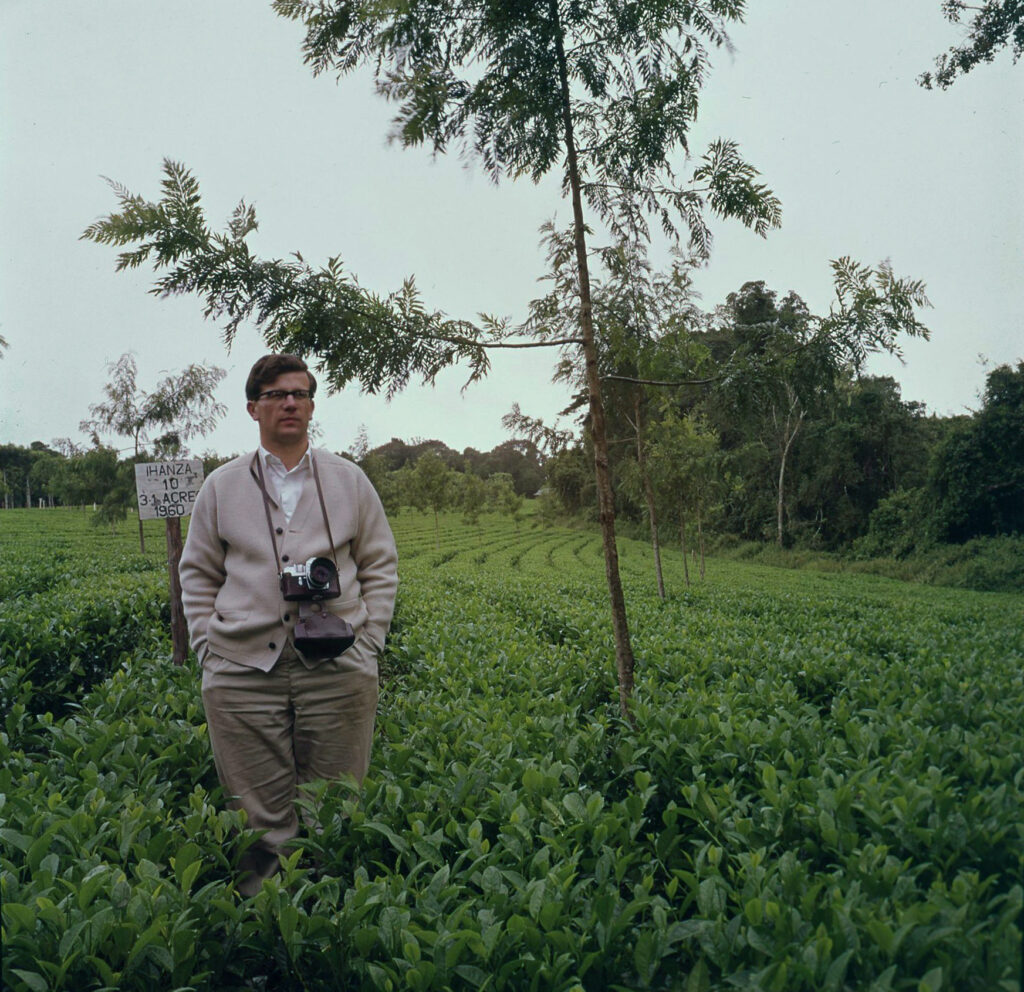
On the 20th April, Flowers and the Spotiswoode art director, Terry Flounders, flew to Africa via Rome, the flight taking over four hours. They changed planes at Khartoum, waiting in an uncomfortable transit area for a flight to Nairobi. “Terry was chatting away . . to a man reluctantly returning to Kenya to manage some timber concern. He said he couldn’t wait to get back to his beloved Cornwall in 3 years’ time, once and for all.” After a wait of several hours they boarded a de Havilland Comet jet. Flowers suffered a severe headache during the flight, but recovered when they landed.
Arriving in Nairobi, they were taken to a private aerodrome where they met their pilot Roy Marsh, who was flying a four seater Cessna. Marsh enjoyed a degree of fame in aviation and literary history as he had been piloting the Cessna-180 in which Ernest Hemingway survived a crash some years earlier. After stowing their cases securely, they took off in bright sunshine, with Terry and Roy sitting in the front seats, and Flowers behind. His initial delight turned to disappointment when they entered cloud, but Marsh, an experienced pilot, ducked in and out of the clouds to show them Nairobi from the air, storks flying in formation and millions of flamingos at the end of a salty lake. As they approached Kericho, just east of Lake Victoria, Marsh banked the aircraft, to give them a view of the tea plantations below. Unfortunately the cloud was thickening and the light was not suitable for photography. They landed on a strip of green grass, Marsh taxiing the aircraft straight into a hanger. From there they were taken in a Ford Zodiac to the Tea Hotel, a colonial-style club house built by Brooke Bond in 1950, and by far the best hotel in Kericho. Rather than staying in the main building, the two visitors had been given a suite of rooms in a nearby bungalow, which had parquet floors, French windows and herbaceous borders outside. Their first visitor was David Russell, who took them in a faded white Vauxhall Cresta to the hotel, to meet the ‘big boss’, nicknamed ‘Beegers’: “He was there, a kind of English Magoo in white shirt, khaki shorts flaying out, long pale brown socks. Cinzano I asked for, by this time I was against whisky and beer . . Pleasant but slightly distant conversation, and off they both went leaving us to have lunch at the hotel. Unbelievable food in large hall-like dining room with about 15 tables, 7 white people sedately eating, scattered all over room, 8 black people wearing white tunics and trousers and green fez hats serving. A huge cold buffet, but besides that a comprehensive table d’hote menu, some twelve items all of which you could have if you were hungry enough. Price 10 shillings.” The Tea Hotel had been built by the company in 1950, perhaps in anticipation of a royal visit to Kericho—indeed just two years later it welcomed Princess Elizabeth and the Duke of Edinburgh on their tour of Africa. A few days later while on safari, Elizabeth learned of her father’s death, and that she was to be Queen. Sold in 1975 to the Kenya Tourism Development Corporation, the hotel in more recent year has become the subject of protracted legal disputes. It is now closed and semi-derelict, although some renovation work has begun in recent months.
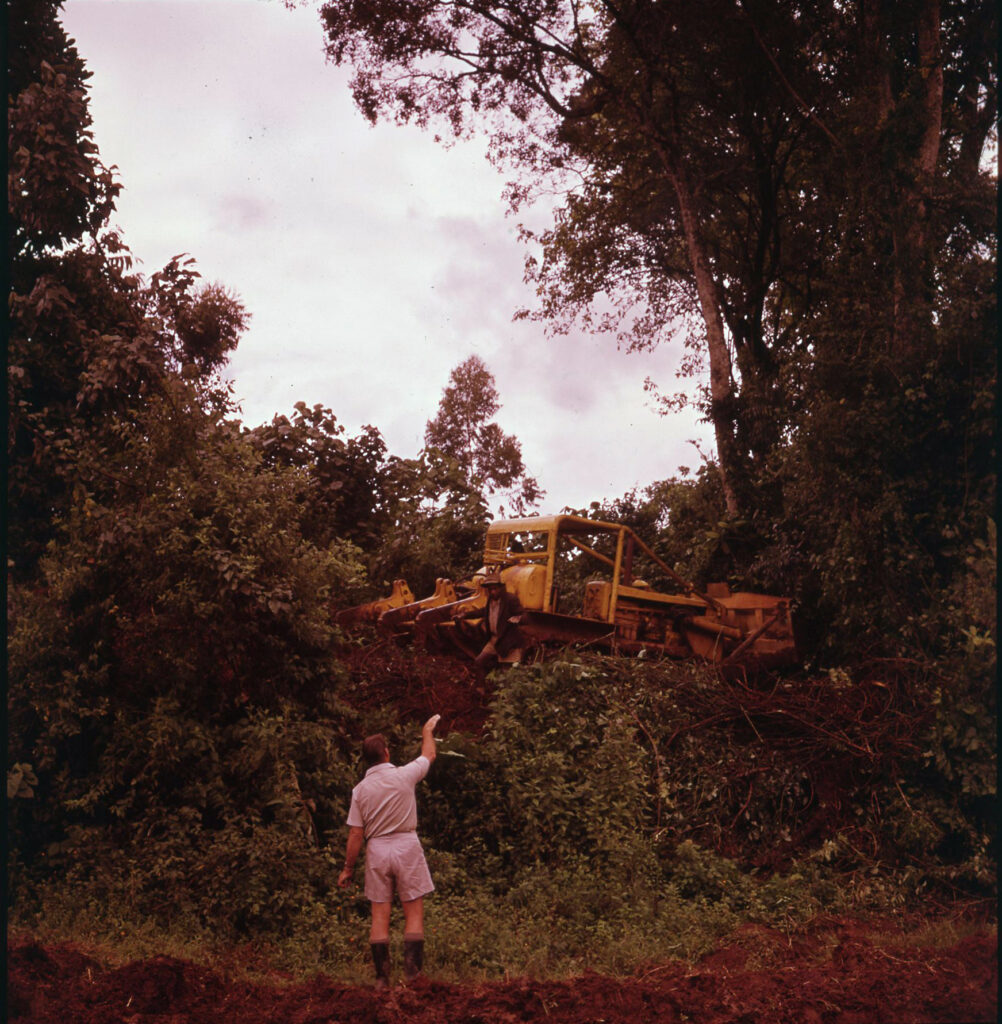
After lunch, Russell took the visitors on a tour of the plantation, and then to his home, where they had tea with his wife, who was French, and their four children. Flowers was saddened to learn that the Russells had been given notice to leave their paradise. “David has been given notice to leave Brooke Bond through no fault of his own. So they will probably have to leave the country. His job has been made redundant as a result of the political events. He was in charge of Brooke Bond free educational service to the Africans which has now been withdrawn.” After Russell gave them a slide show of the whole process of cultivating and processing tea, they returned to the hotel, just in time for a six course dinner. Then it was back to the bungalow, ‘flaked out’. There followed two days of what Flowers described as ‘library photography’. As it was the rainy season, the light was not ideal. The weather was against him, locations were far apart, and advertising photography, which Flowers considered his main purpose, ‘seemed to be going by the board’. He planned to return to Kericho, after he had been to India, when the weather improved. On Sunday, they were taken by ‘Beegers’ on a tour of the estate, the boss driving a Chevrolet fitted with an altimeter, Kericho being over six thousand feet above sea level.
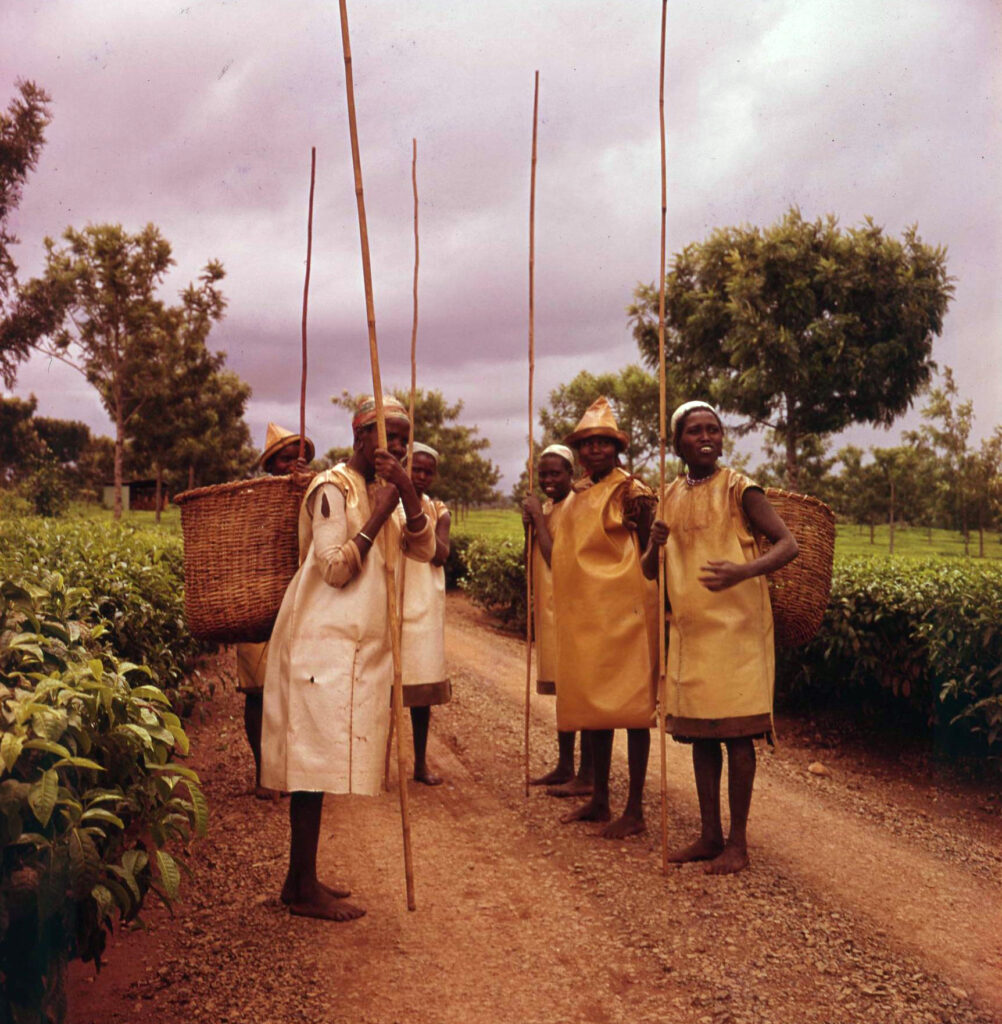

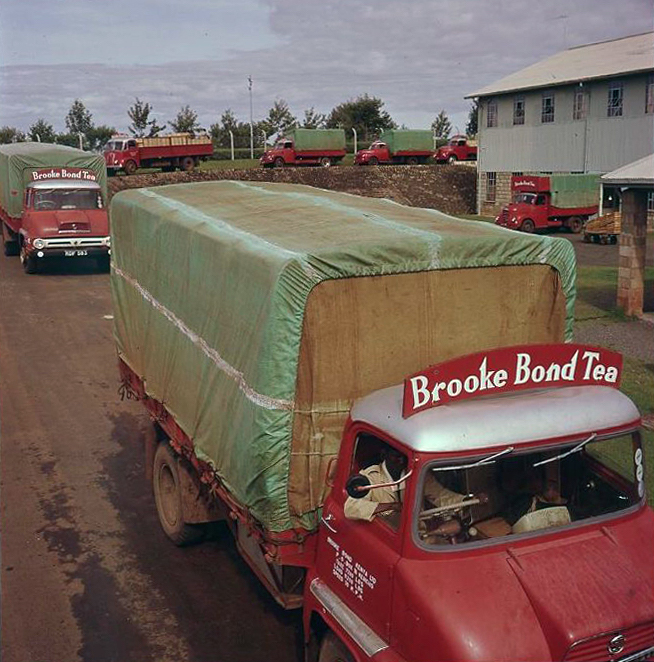
On 25th April, Adrian photographed tea workers, dressed in yellow oilcloth smocks, as they toiled in the fields. Many of the young women were happy to smile for the camera, but there were some sterner glances from some of the male workers. Groups of women pickers posed for the camera, holding long poles and carrying baskets on their backs. Lines of men carrying portable spray canisters sprayed the crops. Supervised by a white man wearing khaki shorts, a yellow bulldozer cleared forest and scrub to expand the planting area. Flowers photographed another white man, carrying a camera, standing in a field in front of a sign reading ‘Hanza’—a plant used in Africa for making beer, and perhaps part of an experimental programme run by Brooke Bond. Packed into large bales, the harvested tea was hauled to warehouses using Massey Ferguson tractors and trailers, with men sitting on top of the bales. Flowers photographed a convoy of trucks, painted in the Brooke Bond livery of bright red, as they rolled out of the warehouse compound. Young men assembled plywood tea chests, nailing strips of tin onto the corners. Lined with aluminium foil and marked ‘Produce of Kenya’ the chests were then sealed for export. Although the commission does not seem to have included photographs for specific ads, Flowers also photographed boxes of PG Tips and Brooke Bond’s Choicest, in the fields, with workers in the background. . Although he used over fifty rolls of film for ‘library’ work, he did manage to take photographs that could be used in advertising, including one of different coloured tea sacks.


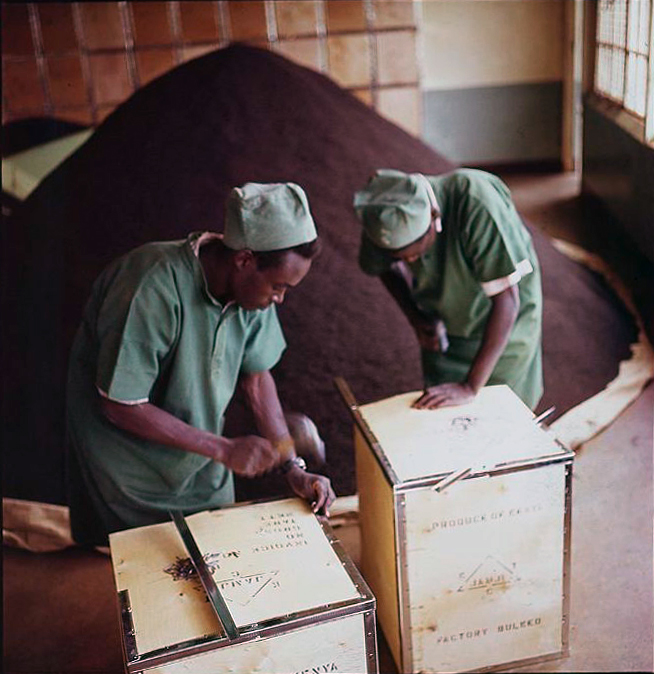
Flowers wrote down his his impressions of Kenya: “Its nearly on the equator but in spite of that it is temperate because of the rain that falls so often. This is what makes it suitable for tea, although it has been grown here a few years. It is not unlike Ireland except that the grass believe it or not is even greener and thicker. The grass on the lawn here for instance is kept very short, but even so, it is like walking on a cinema carpet. We have already encountered lizards frogs slugs and millipedes, but have yet to meet the big game of which there are still plenty. The African villages are marvellous and well kept. Many Africans wear bright colours. The women of certain tribes walk very gracefully. Adolescent girls and boys wear special clothes before and after their circumcision ceremonies. Many adults have large holes in their ears, but westernisation is creeping up, and many of these are having their holes sewn up again!”
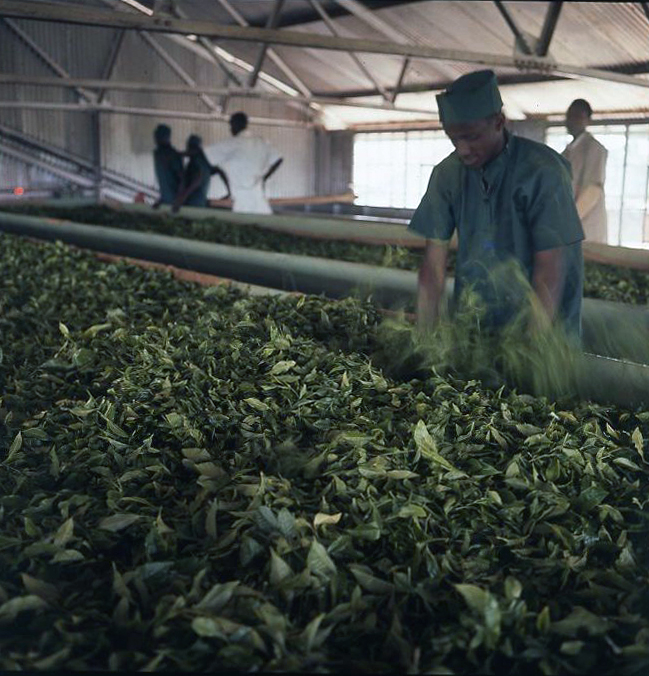

In letters to Angela in London, Flowers describes the local scenery and who they met, but rarely mentions the political situation. In 1963, for plantation employees in Kericho, the work was hard, but by standards of the time in Africa, the pay was not bad. The new Kenyan government was keen to keep companies such as Brooke Bond in operation, tea cultivation being a vital source of revenue for the nation, as well as being a good employer. In 1950, the colonial administration had founded the Tea Board of Kenya, partly to prevent small-scale tea farmers from competing with large producers. But after the brutal suppression of the Mau Mau uprising, more equitable policies were introduced. Dominated by men, the trades unions at Kericho fought effectively on behalf of the plantation employees. Flowers photographed the workers in the fields, but also the processing of tea, which during those years was being increasingly mechanised, particularly after the introduction of the ‘crush, tear, curl’ (CTC) process.

In some ways 1963 was a golden era in the plantation’s history, with optimism surrounding Kenya’s independence and the benefits of Brooke Bond’s colonial and paternalistic approach to estate management evident. Flowers photographed rows of neat small houses built for workers. There were also schools, medical centres and a hospital. In the 1980’s, Brooke Bond was acquired by Unilever and the Kericho estates became just one asset in a giant multi-national company’s portfolio. In more recent years, with the international price of tea dropping, and mechanised harvesting resulting in workers being laid off or placed on short term contracts, the labour situation at Kericho has become shameful, with allegations of ill-treatment, exploitation and poor housing now rife on the former Brooke Bond estate. Such allegations likely contributed to the decision by Unilever in 2022 to sell the Kericho tea plantation to CVC, a Luxembourg-based investment fund.
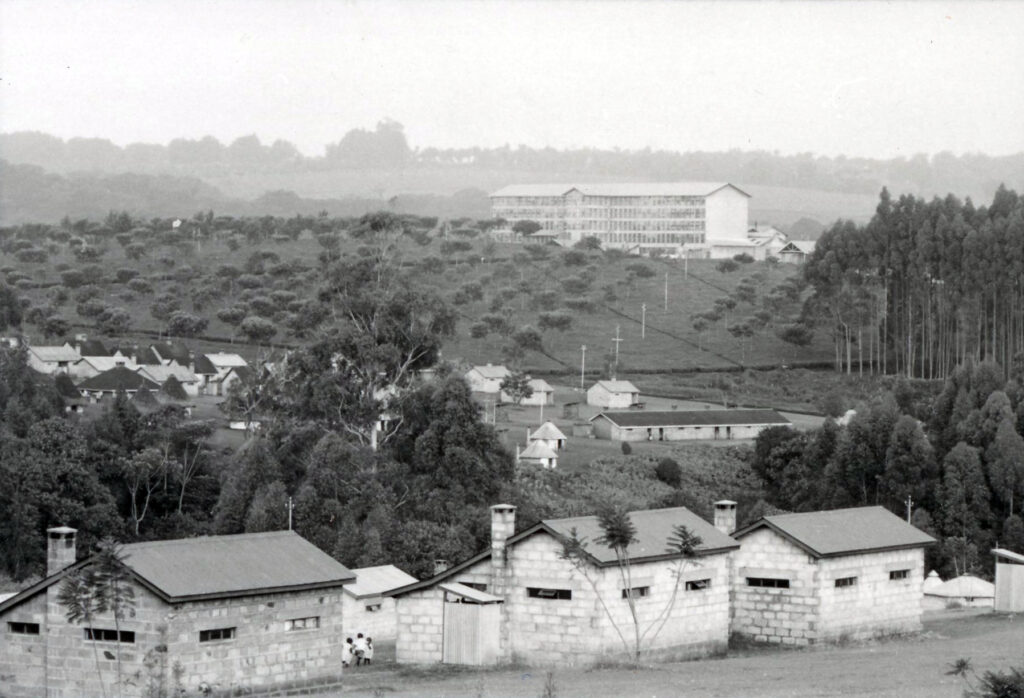
After his visit to Kericho, Flowers met up again with Roy Marsh. Boarding the four seater Cessna, they flew south to Mufindi, in Tanzania, a journey of some five hours, including touching down to refuel at Dodoma: “We went high first of all, above the clouds, put out the trailing aerial to radio Dodoma. Down again to look for elephant, lion, rhino, giraffe, ostrich etc all of which we found even though not easy at this time of the year. I had many attempts at shooting with the Nikon, but it was very difficult, because when flying low the machine is bumping all over the place. Also any point on the ground disappears in an instant. But it was great fun, especially since our excitement gave Roy extra enthusiasm and he really went out of his way for our benefit. It was amusing to know that it was he who was piloting Hemingway when they crashed!”
A good deal of the countryside below, particularly in Tanzania, was scrubland. Landing on a dusty airstrip at Dodoma, they realised how hot it was. They were regarded with slight interest by locals as they sheltered from the sun under the Cessna wing, drinking coffee from a flask. Landing eventually, and two hours late, at Mufindi, a cool oasis situated at a height of some six thousand feet, they were met by Peter Knight and Richard Hartley. They stayed at Knight’s house for three nights. The weather was misty, and over the following days Flowers tried to take advertising pictures. Their visit was not all work. On the first night Knight brought them to the local club, membership of which consisted of some twenty-five men, mostly English, who managed farms and estates. The club had a bar, library and a room for social meetings and fortnightly film showings. “The following was Saturday and we were asked if we would like to see the films. It was not ‘feature night’, but shorts. Nobody knew what they were going to be, but were determined to enjoy them. We all tanked up (first time incidentally). After a couple of hours we entered the ‘cinema’, sat on awful canvas seats. On came the news, 2 months out of date. ‘Royal Events 1960’ came next, which was priceless, all told from a ‘commonwealth’ point of view. About 6 more, like ‘England is a garden’. Can you imagine it. And there was clapping at the end in honest appreciation.” All the men, Flowers noted, were ‘sporty types’ wearing shorts, and playing golf, tennis and rugger. The women played hockey. On weekends, there were expeditions to Dar (Dar es Salaam) and snorkelling in the warm shallow waters.
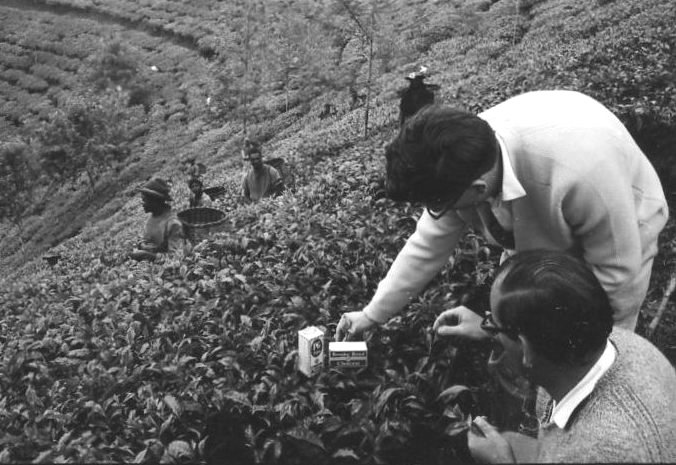

Flowers wondered at how the expatriates got on so well: “I asked them if they suffered domestic differences in such a close community, and was told that because they were so interdependent by force of circumstances they just had to ‘get on’ and in fact did.” The question was not casual. In 1963, Adrian’s wife Angela was not only looking after their young children but also helping out at the studio. Due to Adrian’s illness in 1962, the family had had to leave their house and move to a flat. The studio had not been making money, yet he was determined to keep his staff on. Angela stepped in, to work as his assistant. One of her jobs was to sell surplus photographic equipment, as well as their beloved VW camper van, to raise money to keep the business going. Letters between them, while Flowers was travelling in Africa and India, reveal a growing rift.

Text: Peter Murray
Editor: Francesca Flowers
All images subject to copyright.
Adrian Flowers Archive ©